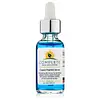What's inside
What's inside
 Key Ingredients
Key Ingredients

 Benefits
Benefits

 Ingredients Side-by-side
Ingredients Side-by-side

Hippophae Rhamnoides Fruit Extract
Skin ConditioningWater
Skin ConditioningGlycerin
HumectantPropanediol
SolventNiacinamide
SmoothingCaprylic/Capric Triglyceride
MaskingDipropylene Glycol
HumectantC12-15 Pareth-9
EmulsifyingAstaxanthin
Skin ConditioningCommiphora Abyssinica Gum Oil
PerfumingHelianthus Annuus Seed Oil
EmollientXanthan Gum
EmulsifyingHydrolyzed Collagen
EmollientHydrolyzed Pearl
Skin ConditioningCopper Tripeptide-1
Skin ConditioningPalmitoyl Tetrapeptide-7
Skin ConditioningPalmitoyl Tripeptide-1
Skin ConditioningBenzyl Glycol
SolventSodium Hyaluronate
HumectantHydrolyzed Hyaluronic Acid
HumectantPvp
Emulsion StabilisingSodium Acetylated Hyaluronate
HumectantGlyceryl Glucoside
HumectantCarbomer
Emulsion StabilisingBiota Orientalis Leaf Extract
HumectantZanthoxylum Piperitum Fruit Extract
Skin ConditioningPolygonum Cuspidatum Root Extract
AntioxidantSclerotium Gum
Emulsion StabilisingBacillus/Folic Acid/Soybean Ferment Extract
Skin ConditioningRosmarinus Officinalis Leaf Extract
AntimicrobialButylene Glycol
HumectantBetaine
HumectantBeta-Glucan
Skin ConditioningArginine
MaskingAdenosine
Skin ConditioningTranexamic Acid
AstringentGlutathione
Tocopherol
AntioxidantBisabolol
MaskingCeramide NP
Skin ConditioningBeta-Carotene
Skin ConditioningXanthophylls
Skin ConditioningFullerenes
AntimicrobialFerulic Acid
AntimicrobialPentylene Glycol
Skin ConditioningHydrogenated Lecithin
EmulsifyingCaprylyl Glycol
EmollientPolyglyceryl-10 Diisostearate
EmulsifyingSodium Polyacrylate
AbsorbentAgar
Masking1,2-Hexanediol
Skin ConditioningEthylhexylglycerin
Skin ConditioningHippophae Rhamnoides Fruit Extract, Water, Glycerin, Propanediol, Niacinamide, Caprylic/Capric Triglyceride, Dipropylene Glycol, C12-15 Pareth-9, Astaxanthin, Commiphora Abyssinica Gum Oil, Helianthus Annuus Seed Oil, Xanthan Gum, Hydrolyzed Collagen, Hydrolyzed Pearl, Copper Tripeptide-1, Palmitoyl Tetrapeptide-7, Palmitoyl Tripeptide-1, Benzyl Glycol, Sodium Hyaluronate, Hydrolyzed Hyaluronic Acid, Pvp, Sodium Acetylated Hyaluronate, Glyceryl Glucoside, Carbomer, Biota Orientalis Leaf Extract, Zanthoxylum Piperitum Fruit Extract, Polygonum Cuspidatum Root Extract, Sclerotium Gum, Bacillus/Folic Acid/Soybean Ferment Extract, Rosmarinus Officinalis Leaf Extract, Butylene Glycol, Betaine, Beta-Glucan, Arginine, Adenosine, Tranexamic Acid, Glutathione, Tocopherol, Bisabolol, Ceramide NP, Beta-Carotene, Xanthophylls, Fullerenes, Ferulic Acid, Pentylene Glycol, Hydrogenated Lecithin, Caprylyl Glycol, Polyglyceryl-10 Diisostearate, Sodium Polyacrylate, Agar, 1,2-Hexanediol, Ethylhexylglycerin
Ingredients Explained
These ingredients are found in both products.
Ingredients higher up in an ingredient list are typically present in a larger amount.
Butylene Glycol (or BG) is used within cosmetic products for a few different reasons:
Overall, Butylene Glycol is a safe and well-rounded ingredient that works well with other ingredients.
Though this ingredient works well with most skin types, some people with sensitive skin may experience a reaction such as allergic rashes, closed comedones, or itchiness.
Learn more about Butylene GlycolCopper Tripeptide-1 (GHK-Cu) is a skin repairing ingredient known for its ability to boost collagen, improve firmness, and support skin regeneration.
It is a complex made up of a naturally occurring peptide (glycine-histidine-lysine) and copper, an essential trace element.
While studying wound healing, researchers noticed GHK-Cu stimulated hair follicle enlargement and growth by keeping hair in its active growth phase longer. This has made it a promising ingredient for hair regrowth treatments.
Some people have reported increased facial hair. While GHK-Cu can make your hair follicles bigger, it usually doesn’t turn soft, barely-visible facial hairs into thick, dark ones.
Anecdotal reports suggest that overusing copper peptides might lead to premature aging due to excess free copper or enzyme imbalances. This claim isn’t backed by large-scale studies.
Unfortunately, there are limited human studies for this ingredient. While early results are promising, many studies are either small, in-vitro, or not rigorously controlled.
For example, there is a 1998 study that explored the effects of copper tripeptide, vitamin C, tretinoin, and melatonin on skin repair and collagen synthesis.
After one month, increased procollagen production was seen in 7 out of 10 participants using copper tripeptide (more than those using vitamin C, melatonin, or tretinoin.
While the study was exploratory, it offers early evidence that copper tripeptide may support collagen production. Larger, well-designed trials are still needed to confirm its potential and understand individual responses.
Read more about other common types of peptides here:
Learn more about Copper Tripeptide-1Palmitoyl Tetrapeptide-7 (formerly Palmitoyl Tetrapeptide-3) is a lab-made peptide with anti-inflammatory and skin-repairing benefits. It's made up of four amino acids (glycine, glutamine, proline, and arginine) and palmitic acid (which helps it penetrate skin more effectively).
This ingredient helps reduce inflammation by limiting the production of interleukin-6 (IL-6), a chemical that triggers inflammatory responses, particularly after UV exposure.
Less inflammation = slower collagen breakdown and a longer-lasting, youthful appearance.
Palmitoyl Tetrapeptide-7 also stimulates collagen production and supports a healthier skin barrier.
Over time, this can improve skin firmness, hydration, and reduce the appearance of fine lines. It’s commonly paired with Palmitoyl Tripeptide-1 in the well-known Matrixyl 3000 complex for enhanced anti-aging effects.
This ingredient has been shown to be effective and safe in cosmetic use and you'll typically find it in small amounts (less than 0.01%).
Due to its palmitic acid base, it may not be safe for Malassezia folliculitis.
Read more about other common types of peptides here:
Learn more about Palmitoyl Tetrapeptide-7Propanediol is an all-star ingredient. It softens, hydrates, and smooths the skin.
It’s often used to:
Propanediol is not likely to cause sensitivity and considered safe to use. It is derived from corn or petroleum with a clear color and no scent.
Learn more about PropanediolWater. It's the most common cosmetic ingredient of all. You'll usually see it at the top of ingredient lists, meaning that it makes up the largest part of the product.
So why is it so popular? Water most often acts as a solvent - this means that it helps dissolve other ingredients into the formulation.
You'll also recognize water as that liquid we all need to stay alive. If you see this, drink a glass of water. Stay hydrated!
Learn more about Water